Indoor perennial plant called oxalis (from the Latin? Xalis - Oxalis) is becoming increasingly popular in recent years. Such a flower is appreciated not only for its spectacular decoration and pleasant aroma of flowers, but also because of its unpretentiousness. In our latitudes, acid field is grown in almost every home and therefore many know how to care for a plant. Those who are not familiar with acidity, but would like to grow it at home, will help this article. It proposes the main provisions for which care is necessary.
Plant description
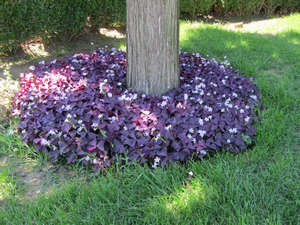 Decorative kislitse most often found in homes and apartments. Its leaves are triangular in shape and burgundy, gathered in a lush bush, can decorate any interior, especially during flowering.
Decorative kislitse most often found in homes and apartments. Its leaves are triangular in shape and burgundy, gathered in a lush bush, can decorate any interior, especially during flowering.
The representative of the Kislits family, Oxalis includes about 800 species, united in one genus under the common name. In nature, these plants grow in southern and central regions of America and southern Africa. Many of them are grown in the open air, decorating flower beds and gardens ( see the photo), while others are popular in indoor floriculture. At the same time, reproduction of those and other species will not be difficult even for beginners.
Kislitza owes its unusual name to the unusually sourish taste of foliage. And because such a flower culture has found its use in cooking as a seasoning for salads, we can recognize the plant by another name - “hare cabbage”.
Growing at home, triangle acid (another name of the flower) is not capricious. Oxygen care at home requires more thorough in mind features, but if it is done according to all the rules, then it will become a very useful information assistant for flora lovers.
How to create the most comfortable conditions for plants in the house
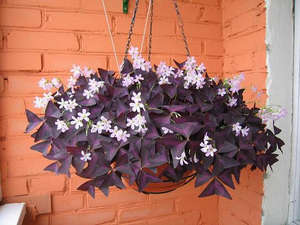 As well as for many exotic plants that came to us from hot countries, the care of fur should be appropriate. In general, the creation of conditions for growing kislitsy in the house should consist of:
As well as for many exotic plants that came to us from hot countries, the care of fur should be appropriate. In general, the creation of conditions for growing kislitsy in the house should consist of:
- proper lighting;
- optimum temperature and humidity;
- regular watering;
- periodic dressings and transplants;
- flower treatment (in case of illness or pests).
Lighting and location in the house
 Most of the photos show us the location of the fish at home in the most lighted areas. But it should be noted that the light it needs is soft and diffused, since the direct rays of the sun can leave burns on the tender foliage of the flower. Suitable for plant and light partial shade.
Most of the photos show us the location of the fish at home in the most lighted areas. But it should be noted that the light it needs is soft and diffused, since the direct rays of the sun can leave burns on the tender foliage of the flower. Suitable for plant and light partial shade.
Triangular oxygen can be located in summer near shaded windows or on a glazed balcony (veranda). In winter, the flower will feel comfortable on any windowsill. It is during the period from the beginning of winter to the arrival of spring that the ultraviolet rays of the sun will not harm the flower.
Be sure to carry out such care, it should be remembered that oxalis oxalis absolutely does not tolerate drafts and sudden changes in temperature. Therefore, try to take into account the peculiarity of the plant in this regard. If necessary, this unique flower should be taught gradually to new conditions.
Temperature conditions
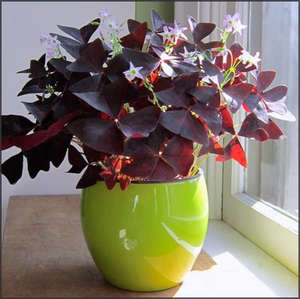 Triangular oxygen, which grows in room conditions, needs an optimal temperature. It is important that the room was:
Triangular oxygen, which grows in room conditions, needs an optimal temperature. It is important that the room was:
- in summer ranging from +20 to +25 degrees;
- in winter (at rest), it is necessary to adhere to the indications of + 14- + 18 degrees.
For some varieties of shrub (Deppay, Pink), care in terms of temperature should maximize their transition to the rest stage. Therefore, representatives of these varieties of shale about the end of October should be taken to a cooler room, where the winter temperature does not exceed +14 degrees.
Watering
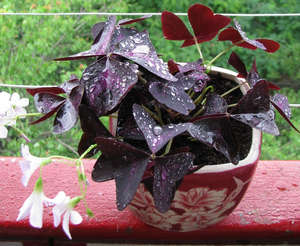 Care in terms of watering for amazing acidity, which grows at home, should include regular and abundant procedures for moistening the soil. But only in the spring and summer periods. And with the arrival of autumn, the flowers begin to be prepared in the dormant stage, reducing watering in order to completely reduce it to no in winter.
Care in terms of watering for amazing acidity, which grows at home, should include regular and abundant procedures for moistening the soil. But only in the spring and summer periods. And with the arrival of autumn, the flowers begin to be prepared in the dormant stage, reducing watering in order to completely reduce it to no in winter.
As previously indicated, for different types of acidic, conditions may vary. So, for example, for the “Deppiey” variety of tartfish, in which the sleep stage lasts from December to the end of January, watering is not carried out at this time, “Pink” doesn’t get watered from October to November, and throughout the winter.
Watering can be renewed when young shoots begin to appear. With their appearance, acid oxides are transferred to a warmer room.
Regarding humidity, the flower grows better at home, where the air is sufficiently humid. Not bad trioxide refers to spraying. In such procedures, the plant needs, mainly, on warm and hot days. In winter, spraying, as well as watering, it is better to stop completely.
Feeding
It is recommended to conduct dressing for room ornamental in the period from April to August regularly. Every 2-2.5 weeks the plant is fertilized with complex organic and mineral preparations. As a rule, suitable for such a flower that grows at home, fertilizers for flowering plants, which can be purchased at a flower shop.
When and how to transplant
Transplant sour annually. It is better to carry out such procedures in the spring. To transplant a plant, it will be necessary to prepare a new tank, drainage and substrate.
Oxygen over the year grows well and becomes a very lush bush, as the photo shows. And if you do not plan its division, removal of a part of a plant, then a new pot is worth taking a larger size. If you will remove a part of the expanded flower, then the capacity can be the same in size as the previous one.
The bottom of the new vessel must be laid out with drainage to ensure good drainage of water. From above, you can fill the substrate. Usually, for planting an acidic plant, take a ready ground, which is also commercially available at any flower shop. But at home, you can prepare a soil mixture yourself. Enough to prepare:
- 1 part of sod land;
- 1 hour leaf;
- 1 part peat;
- 1 hour of sand.
The quality of the soil, as well as the ratio of the components, will depend not only on complete care, but also the development of the plant. So, for example, if trioxide grows in the soil with excess nutrients, then thick deciduous mass will replace lush flowering.
How to reproduce such a flower culture
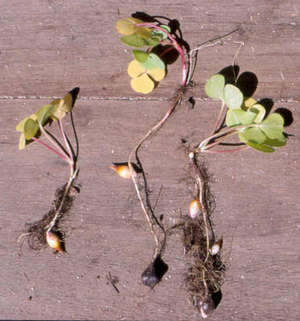 Caring for oxalis oxalis, which grows in indoor conditions, can be much easier if you perform all the recommended procedures at the right time. To one of these can be attributed, and plant reproduction.
Caring for oxalis oxalis, which grows in indoor conditions, can be much easier if you perform all the recommended procedures at the right time. To one of these can be attributed, and plant reproduction.
This type of plant, as a decorative acid, can multiply in one of the ways:
- Bulbs;
- Tubers;
- Cuttings;
- Leaves.
In contrast to the garden varieties, the reproduction of which takes place with the help of seeds, it is not thus cultivated for the breeding of ornamental souring.
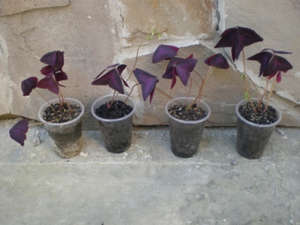 In general, the reproduction of such a flower culture with the help of bulbs and tubers, which shows a photo, occurs by their separation during transplantation. In the future, this planting material is planted in individual pots. From 5 to 10 young tubers (bulbs) can be planted in one container in order to get a lush bushy plant as a result. Care for seedlings of kislitsy at home should include rare moderate watering and the location of the container with plantings in a cool room.
In general, the reproduction of such a flower culture with the help of bulbs and tubers, which shows a photo, occurs by their separation during transplantation. In the future, this planting material is planted in individual pots. From 5 to 10 young tubers (bulbs) can be planted in one container in order to get a lush bushy plant as a result. Care for seedlings of kislitsy at home should include rare moderate watering and the location of the container with plantings in a cool room.
To light the pots can be substituted only when the first shoots appear. A month later from the planted tubers (bulbs) you will grow a lush bush of sour.
Another method involves the reproduction of this indoor flower by obtaining cuttings from an adult plant. After cutting, the shoots should be placed in a container with water so that after 2-2.5 weeks to get the young shoots. When the length of such shoots will reach 1.5 cm, it is possible to continue the reproduction of the plant, replanting such planting material in the previously prepared separate pots with soil. How just the transplanted young cuttings will look, clearly shows the photo.
Growing problems
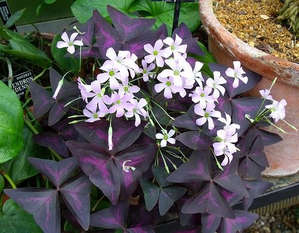 Triangular oxygen is rarely susceptible at home to disease, as well as pest infestation. In general, diseases on acidic plants can occur as a result of attacks on the plant of whitefly, ticks, aphids, cherventsa, scale insects.
Triangular oxygen is rarely susceptible at home to disease, as well as pest infestation. In general, diseases on acidic plants can occur as a result of attacks on the plant of whitefly, ticks, aphids, cherventsa, scale insects.
In general, if you provide a little face full of care, it will delight you with its unsurpassed appearance, as in the photo.
Oxalis or chislitz are herbaceous perennials, they got their name because of the sour taste of the leaves. Varieties reach a height of 30 cm, under the ground the plant forms tubers or bulbs.
Oxalis or Kislitza are herbaceous perennials, they got their name because of the sour taste of the leaves.
The leaflets are petiolate, dark green or spotty. The flowers are small, the correct form. Their color varies from yellow to violet, after flowering fruits are formed, which give small seeds. Some varieties of oxalis can be planted in the open field.while others are grown in a greenhouse and living space.
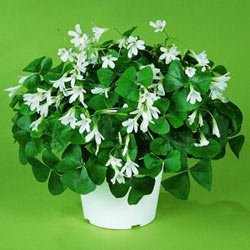
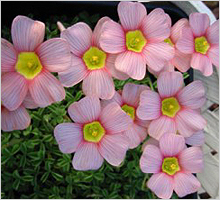

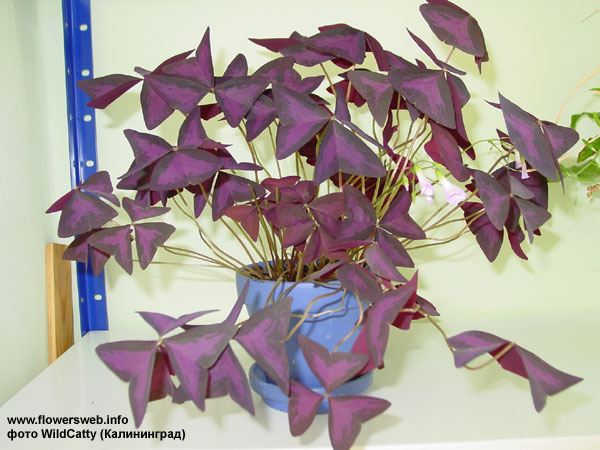
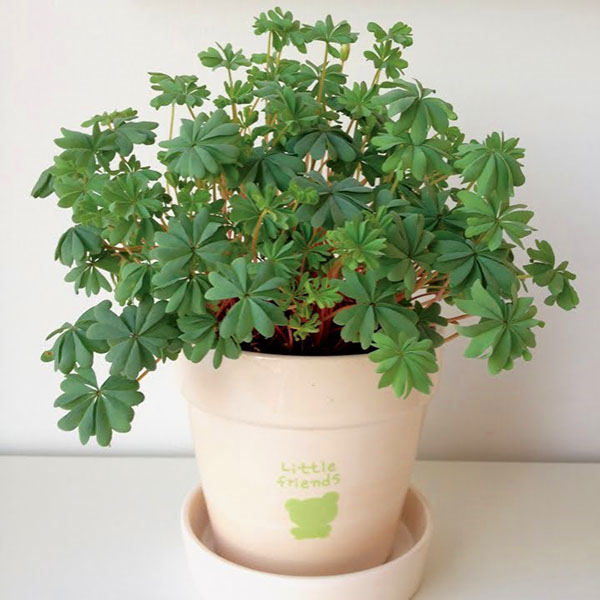
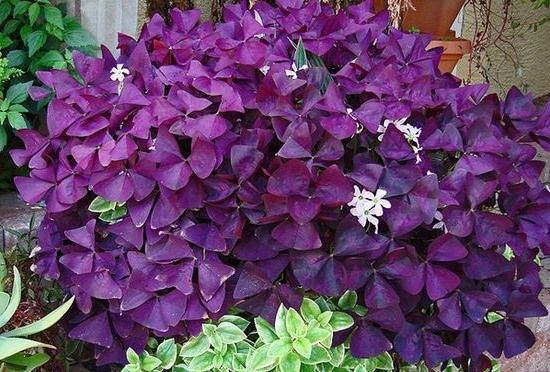
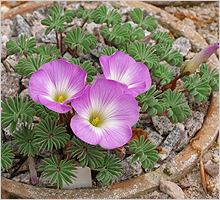
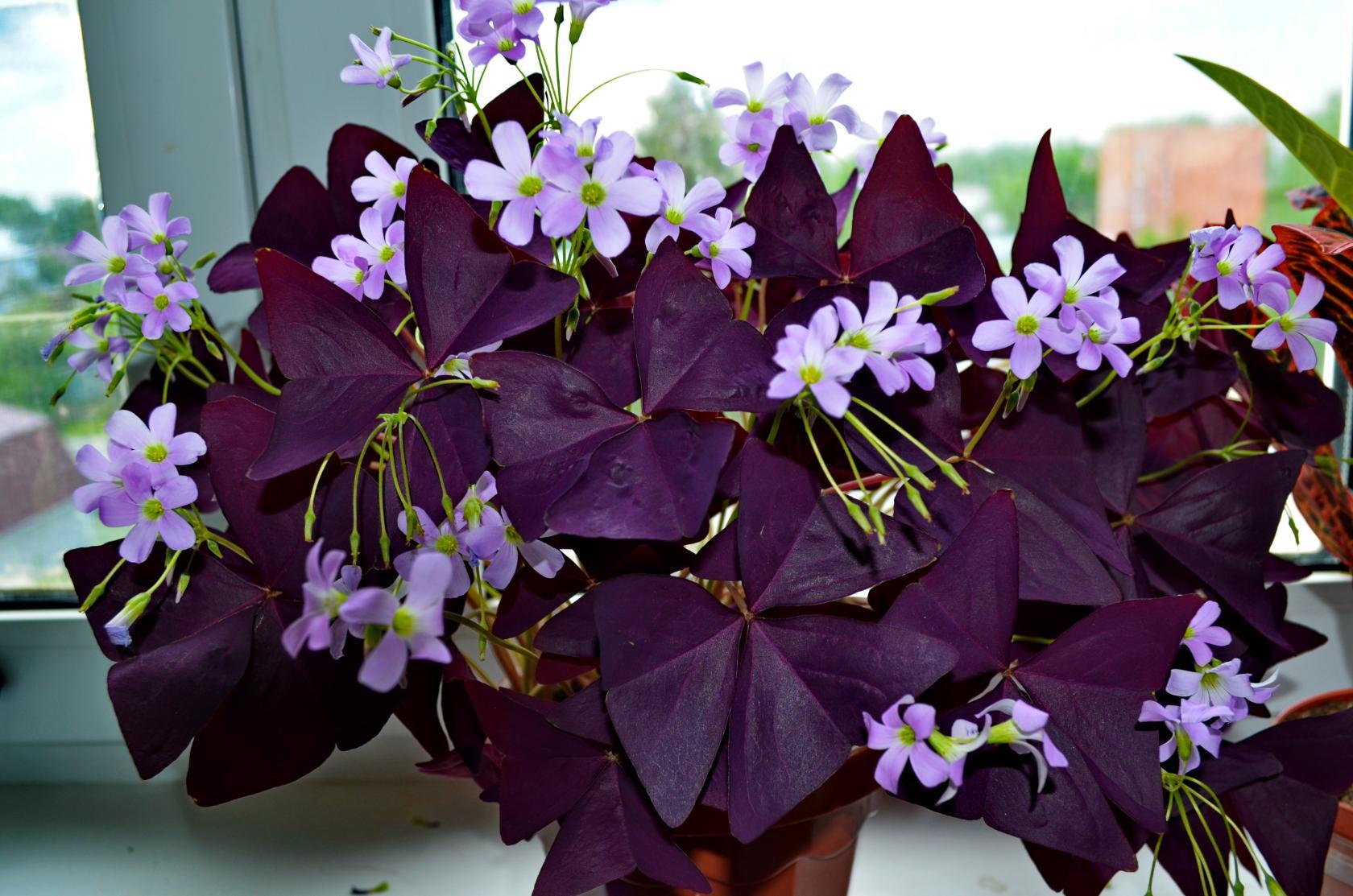
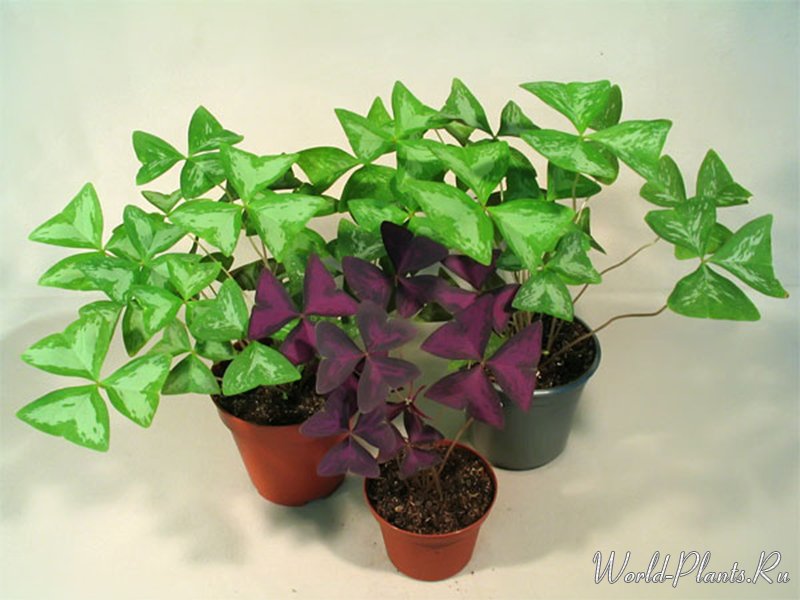
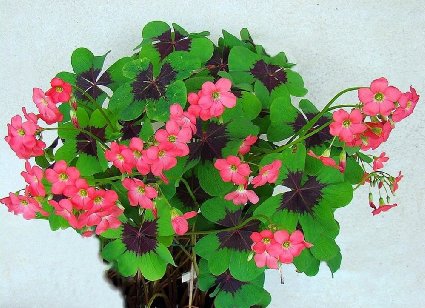
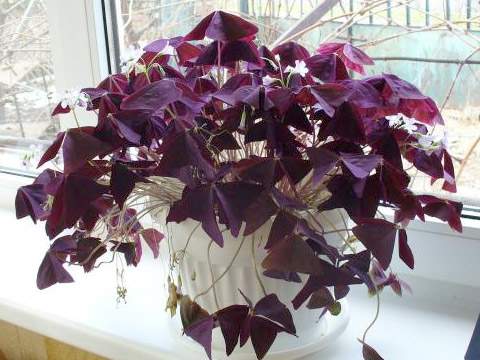
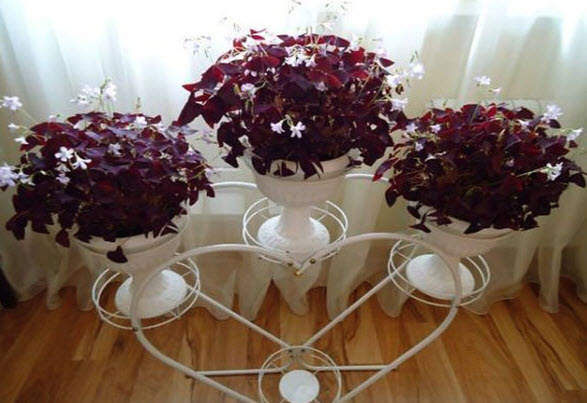
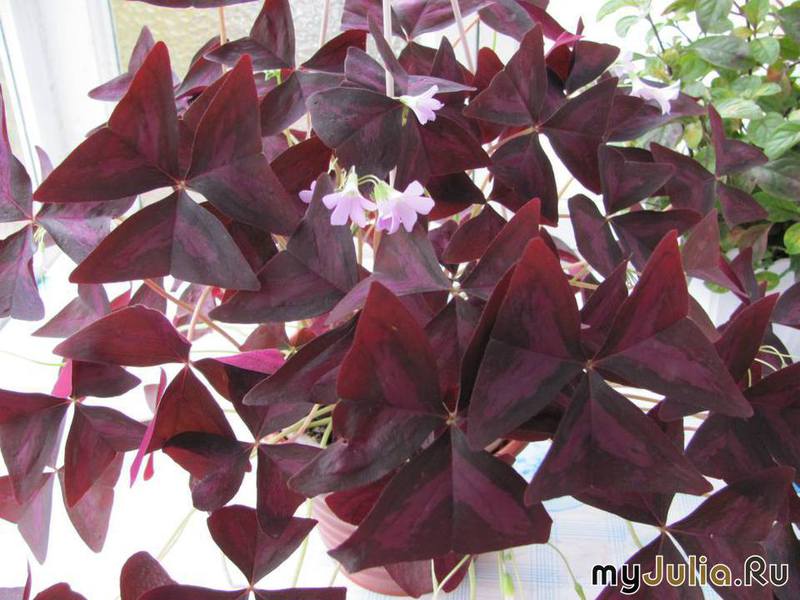
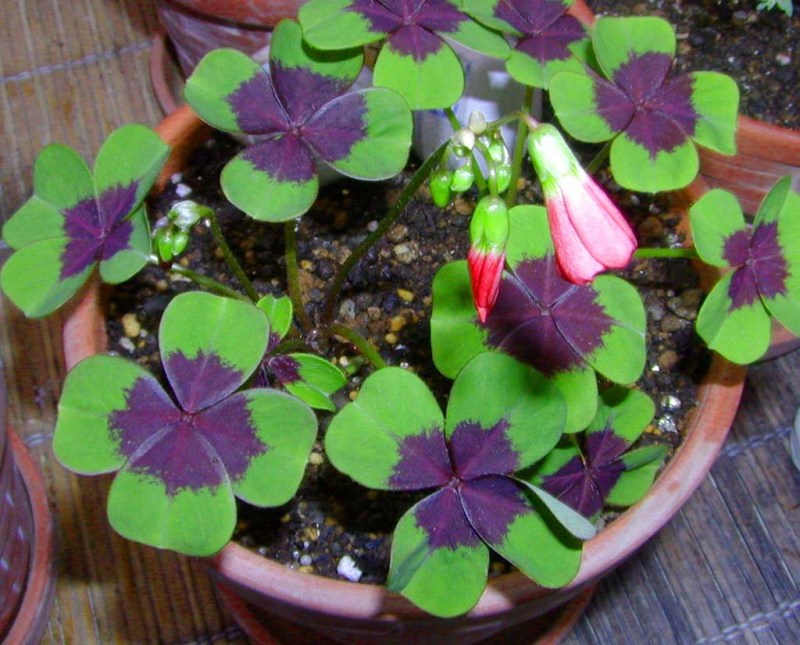
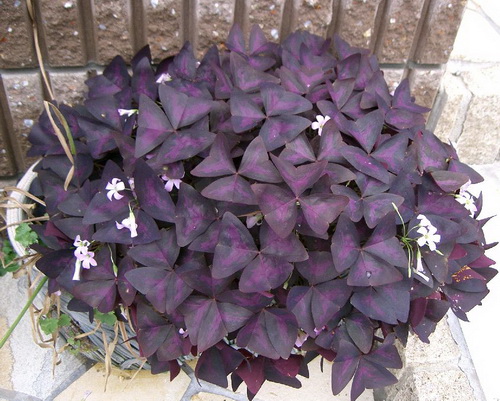
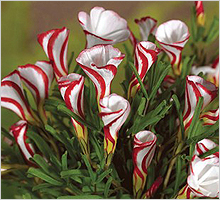
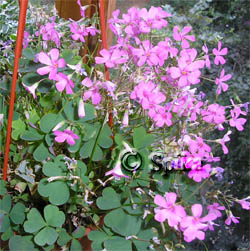



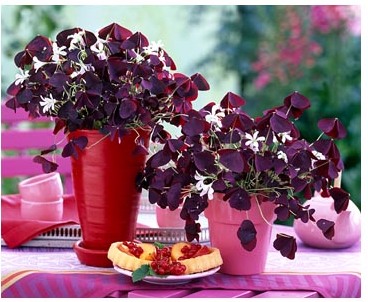
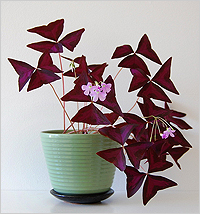
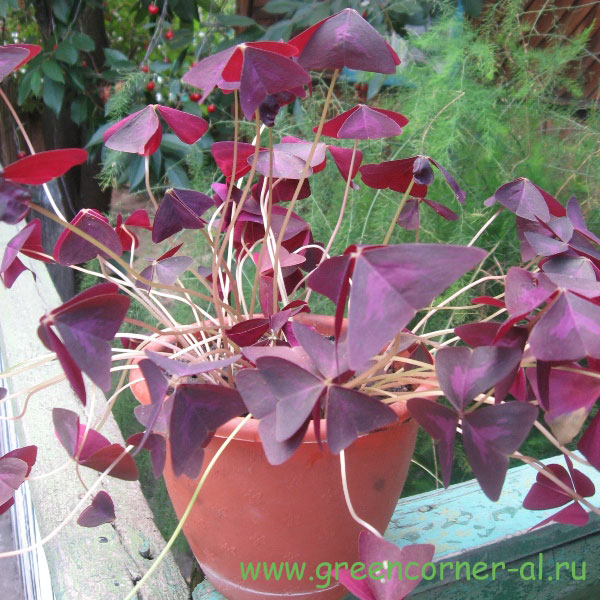
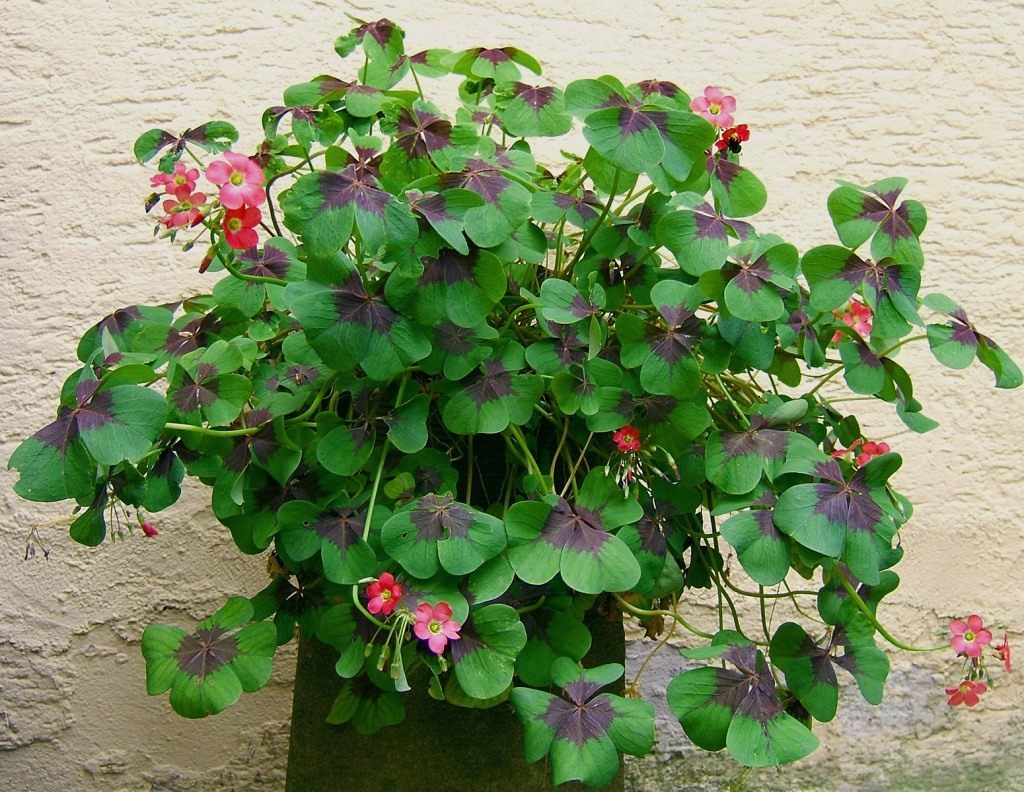
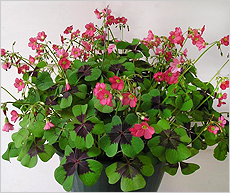

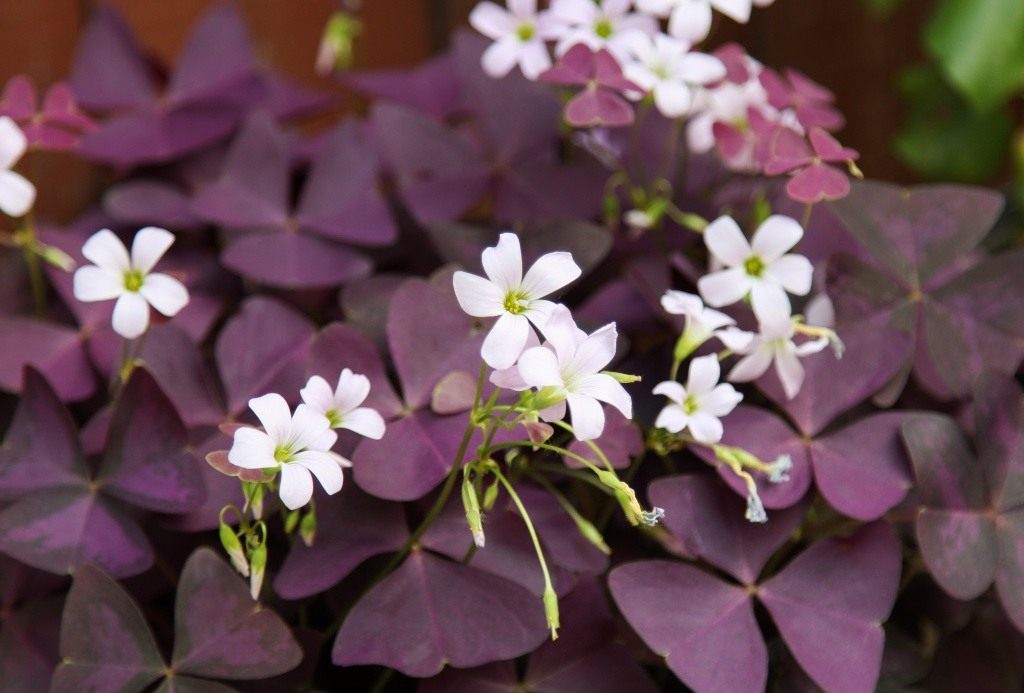
Popular varieties
There are many varieties of this plant.. Many of them are grown in order to decorate the garden plot, because the flower should be chosen on the basis of color.
| Title | Description | Growing conditions |
| Oxalis deppei | Perennial, forming underground tubers. The leaves are notched, have a purple-brown pattern. Flowers crimson or red with a yellow base, appear in August. In winter, the green mass falls | The plant is decorative and suitable for home floriculture |
| Multicolored Oxylis (Oxalis versicolor) | Perennial plant varieties "Versicolor" is famous for white and red striped flowers, similar to candy. In favorable conditions, they bloom all year round. | Indoor flowers are unpretentious and grow well indoors |
| Oxalis Golden Cape (Golden cape) | The flowers are like vanilla candies, they are painted in yellow-red color. The leaves are pale green, small | Most often, this variety is used to decorate summer cottages and flower beds. |
| Oxalis glandular (Oxalis adenophylla) | Small leaves of a light green color resemble clover. The flowers are large, pale purple shade | Plants take root in a garden in sunny places. |
| Convex Oxygen (Oxalis Convexula) | This variety is most popular among fans of indoor flowers. The foliage is small, dense. The flowers are quite large, have a pinkish tint. | The variety is suitable for growing indoors. |
| OxalisIronKross (Oxalis iron cross) | The flower of this variety is very beautiful, bell-shaped. Its color is pink-red, and the leaves resemble clover. | Such oxalis is suitable for planting at the dacha |
| Oxyl Violet (Oxalis) | Purple leaves are triangular in shape, and the flowers are pink, white or yellow. | Suitable for both indoor and outdoor growing. |
| Oxygen pressed (Oxalis depressa) | The foliage is gray-green, each leaf has a trifoliate shape. Dark pink flowers with yellow spots | This variety is cultivated in summer cottages and gardens. |
Peculiarities of home care
In order for the plants in the room to preserve the beauty and delight you with bright flowers, the following rules must be observed:
- providing sufficient lighting;
- maintaining a comfortable temperature (from 18 to 25 ° C);
- regular watering;
- the introduction of additional power.
After acquiring oxalis, it must be transplanted into a free pot and placed on the windowsill. It is best to perform planting in the spring or summer, when the plant leaves the state of rest.
Oxalis: care and cultivation (video)
The soil should be selected loose, neutral, consisting of the following parts:
- turf;
- leaf mixture;
- peat;
- humus;
- river sand.
The soil should have a high level of acidity, and be sure to place a drainage layer on the bottom of the tank. For this purpose, crushed brick, pebbles or expanded clay is suitable.
Oxygen needs regular fertilization with mineral and organic fertilizers. For a noticeable result, it is recommended to use liquid additives, for example, mullein diluted in large quantities of water or chicken droppings. It is important to knowthat food is applied only during the growing season, and in the resting stage the plant does not require additional substances.
Water oxalis room should be defended with water no more than 2 times a week. In summer and spring it is also recommended to irrigate the soil moderately, but with the onset of cold weather, the frequency of irrigation decreases.
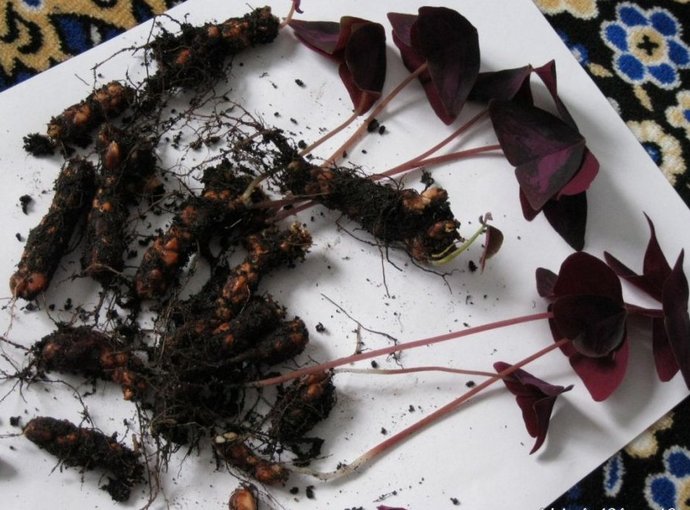
After acquiring oxalis, it must be transplanted into a free pot and placed on the windowsill
Growing Kislitsy on a bed
Oxalis growing in open field prefers diffuse lighting. This flower likes well-moistened and loose soil., why gardeners are advised to dilute the soil with peat and compost. Having chosen a place for a flower bed, place drainage in the form of small pebbles or expanded clay at the bottom of the pit to better allow moisture to pass through the layers of soil.
Plants are planted in the open ground in mid-May.when warm weather is established and the threat of frost has passed. Holes are dug at a distance of 10 cm from each other, after planting the sour face should be watered moderately. Planting oxalis tubers into the ground is allowed in both spring and autumn. It is important in the latter case to choose cold-resistant varieties of flower culture.
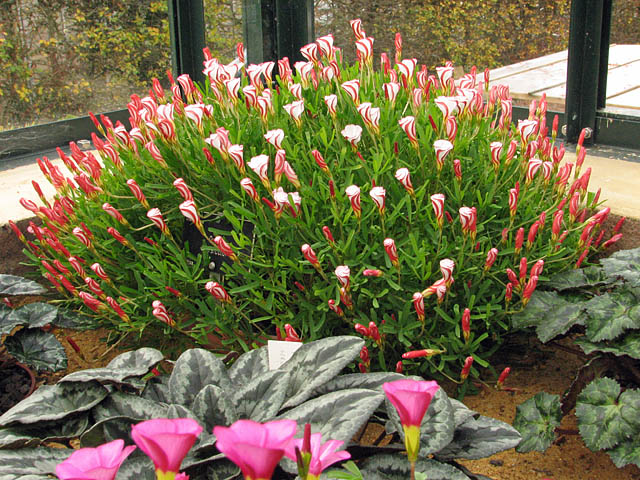
Oxalis growing in open field prefers diffuse lighting
Growing acid on the summer cottage, it is necessary to systematically water this plant, as it is poorly resistant to drought. The lack of water adversely affects the decorativeness of flowers and often causes their death. Water a flower bed as needed, and in wet weather it is best to stop irrigation altogether. During the drought period, it is enough to moisten the soil 2 or 3 times a week. Experienced gardeners plant oxalis among large stones, which maintain the optimum level of soil moisture and protect it from drying out.
If the earth is rich in organic matter, then feeding in the open ground can not hold. As a rule, diluted organic fertilizers or mineral supplements for garden plants are suitable as an additional food, just over the summer it is enough to add nutrients 2 times.
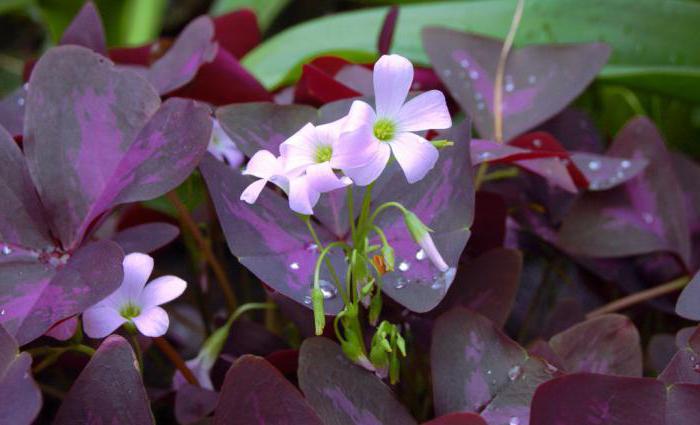
If the earth is rich in organic matter, then feeding in the open ground can not hold
Breeding technology
It is known that oxalis can breed with bulbs or nodules that form around the main root of an old plant. They need to be planted in the ground. Depending on the variety, nodules are placed in pots or on bedswhere the soil is loose and fertile, and after the first shoots appear, they are placed on a place well lit by the sun.
Some types of plants can be propagated by cutting. To do this, collect the cuttings from the parent bush and place them in clean sand. It is important to know that heat is necessary for a successful process, therefore a small greenhouse is created around the plant. A necessary condition for rooting cuttings - regular moistening of sand with water. With the advent of the first roots, the offspring can be planted in separate pots.
How to transplant and propagate oxalis (video)
Problems with growing oxalis
Often, plants in indoor conditions or in the open field become ill and lose their beauty. Why does the leaves of watermelon fade? In most cases, the reason for the changes lies in insufficient watering of the land, since oxalis does not tolerate even a short drought. If the leaves dry and fall in the fall, this may be due to the preparation of the flower for the winter.
It is important to know that in the cold months, care of acid has its own characteristics. At home, you should cut off all the shoots of the plant and transfer it to a cooler room. But in the garden with the arrival of autumn, the tubers need to be dug, washed and dried, after which they are placed in storage in a dry dark place. In the spring, when the soil warms up, they are planted back in a flower bed.
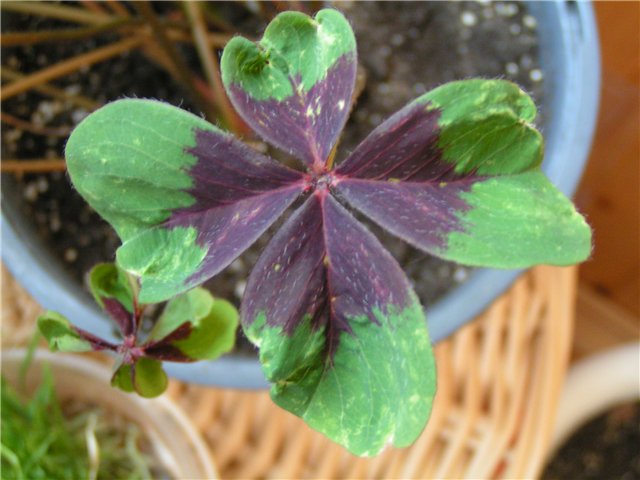
In most cases, the reason for the change lies in insufficient watering of the land.
Use cases in landscape design
Kislitsu usually used in suburban areas and parks as curb plants, they look good on rocky hills. Flowers are perfectly combined with marigolds, asters and carnations, as well as with lungwort, ferns. In addition, oxalis well complements such herbs as thyme, decorative cereals.
Fine flowers of Kislitsy are ideal for creating contrasting spots, as well as for forming flower patterns in large flowerbeds. Some gardeners plant this plant under trees or near shrubs.
At home, oxalis becomes a decoration of the winter garden, perfectly complements the interior and enlivens the window sill with cheerful bright leaves or flowers.
Oxygen or, as it is popularly called, hare cabbage is quite a popular plant among growers. It is grown not only in the garden, but also at home, and is primarily valued for its decorative and unpretentious care. Of particular interest are unusual leaves, the shape of which resembles an exotic flower or butterfly. In addition, the oxalis, although it blooms with inconspicuous-looking flowers, but they exude a very pleasant aroma, which undoubtedly pleases the owners of this wonderful plant. You need to know about what types of oxalis (Kislitsy) are and how to grow a “bunny cabbage” indoors before you buy a flower.
What does oxalis look like and where does it come from
Oxalis (acid) got its name because of the peculiar sour taste of leaflets, which contain a large amount of oxalic acid. “Oxys” literally means “sour” in Latin. The homeland of the plant is America, South Africa and Central Europe, although in the Russian forests one of the species is often found - red ox. Many varieties of this numerous genus (there are about 800 in total) are grown in gardens, as well as in indoor conditions, offices and greenhouses.
In our country, the people dubbed oxalis "hare cabbage" and "kislichkoy." In America, the flower is called "sheep sorrel" and "Indian lemonade", and in Europe - "sour clover."
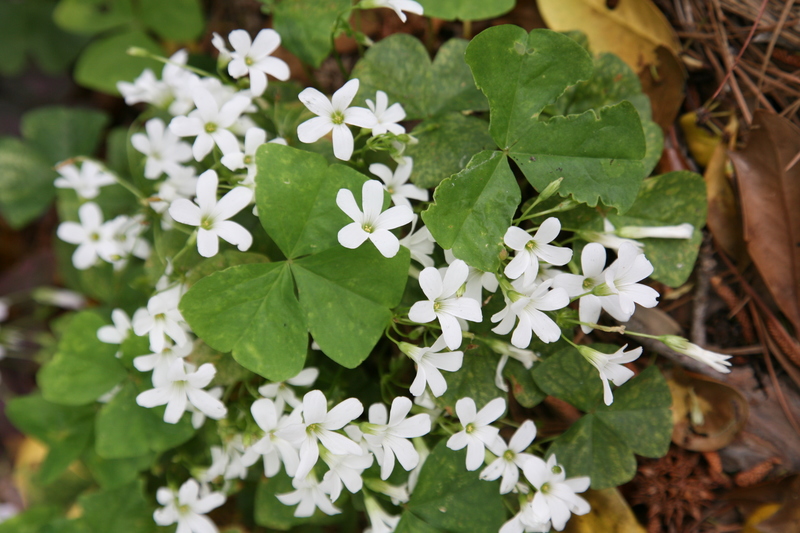
Kislitsy leaflets resemble clover leaves
Oxalis (chislitz) is a rhizome and tuberous plants. They are both annual and perennial. Peristosyllate or ternate leaflets in oxalis are located on long and thin petioles. Painted in different shades from light green to purple.
The flowers are small, composed of five petals. A remarkable feature of the Kislitsa is its expressive veins on the petals and the “exploding” fruit capsules of an elongated shape, which can “shoot”, as it were, with small seeds, if you touch them lightly. Because of this feature, the reproduction of some oxalis species, for example, hornberry is very difficult to stop, and the plant can become a weed when grown in the garden.
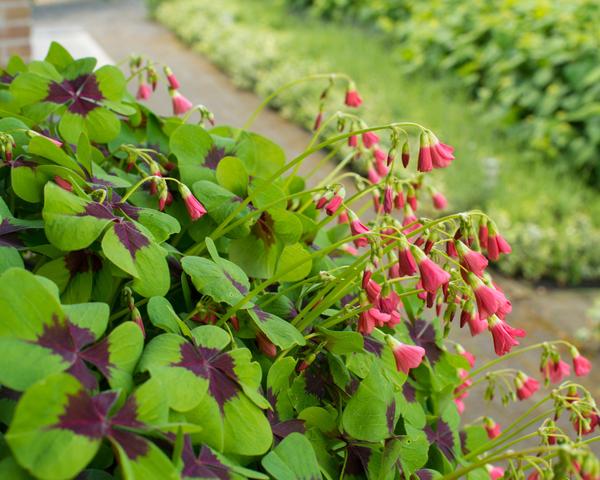
Oxygen can decorate the flower garden and the interior of the room.
Another characteristic feature of the plant is that under any adverse conditions, whether it is too bright light, darkness or mechanical irritation, oxalis flowers slowly close, and the leaves fold and wilt.
Growing under the conditions of room conditions oxygen does not require special conditions, the plant is not capricious and can put up with some flaws in agricultural technology. But still to get a lush bush with bright leaves, “bunny cabbage” you need to create suitable conditions and good care.
Types of indoor oxalis
In room conditions, grown several types of acido. Among them are the following:
- Common. A small bush that spreads through the rhizome. On creeping shoots appear trifoliate leaves of a light green shade on long petioles. In spring, the plant blooms with small single flowers located on thin peduncles, the length of which is 5–10 cm. The petals are white with purple veins. There is a form with pink flowers. Common sour can be grown in containers, as well as in gardens as a ground cover.
- Rozhkovaya. The look differs leaves with a beautiful cherry-brown shade of foliage and small flowers, painted in yellow. The plant is frost-resistant and can be grown not only indoors, but also in a flower garden. However, there it quickly grows and becomes a weed.
- Triangular. The homeland of the species is sunny Brazil. The plant has purple, pink or white flowers and dark purple leaf blades. What makes the flower look incredibly attractive.
- Deppa (four leaf). The species is originally from Panama and Mexico. This is one of the most famous kislits, the leaves of which consist of four parts with a base, painted with smears of burgundy or dark purple color. At the top of the leaves have a small notch. The flowers, collected in umbellate inflorescence, have a crimson-red hue. The plant is bulbous, while the Depp roots are edible. Iron Cross (Iron Cross) is considered to be one of the most popular varieties of four-leaf green leaves.
- Glandular. The flower is one of the most common garden species of Kyslitsy, but it can be grown indoors. The oxalis of the iron leaf forms a small compact bush with a diameter of about 15 cm and a height of about 8 cm. The leaves consist of several lobes, which number from 9 to 22 pieces. They are painted in gray-green. It blooms iron-leaved large silver flowers, decorated with pink strokes and streaks.
- Bowie. A rather thermophilic type of oxalis, so it is grown mainly at home. Leathery leaves are painted in light green and are located on shoots 20–25 cm high. Flowering occurs at the end of spring, during this period oxalis Bowie dissolves dark pink buds.
- Ragnella (triangular, moth). Very spectacular plant, which is considered the birthplace of Brazil. Ragnell's sour face has incredibly attractive light green leafy plates consisting of three lobes. It blooms for a long time, constantly releasing small white buds. Ragnella is a relatively winter-hardy species, and it can be grown even in flower beds in areas with mild winters.
- Red Compared with other plants of the genus, the bushes of this species are quite tall. Red sulphur reaches 40 cm in height. The leaves consist of three lobes, the distinctive feature of which is a little hairiness at the base. Blooms profusely in summer with red or pink flowers.
- Versicolor (variegated caramel flower).A characteristic feature of the plant is that its snow-white petals have a red border, and the unopened buds resemble lollipop. "In captivity" oxalic Versicolor can bloom almost all year round.
- The obtus. This type of oxalis is a miniature bulbous plant, the height of which is only 10 cm. Its leafy plates are slightly pubescent. Used as a ground cover plant in combination with other larger plants grown in the greenhouse. In summer, Obtusa can be planted in the garden.
- Poor (pressed). The kind of hardy and frost-resistant oxalis comes from South Africa. Triple leaves grow on small and long petioles from small nodules. The flowers are relatively large, dark pink with a yellow center. Blossoms from August to October. Predominantly oxalis is cultivated in the open field, but it can be grown indoors.
Oxalis Ragnell, Depp, iron leaf and other forms of acid on the photo
The most comfortable conditions for plants in the house - the table
How and when to replant
Oxalis grows very quickly, so the flower requires an annual transplant, which should be carried out in the spring with the beginning of the active growing season. In the same period, you can multiply acidic. If you do not plan to get new copies, then take the pot more than the previous one by 2 cm. If you divide the plant into several parts, then leave the previous capacity.
At the bottom of the vessel lay drainage, which will help ensure the discharge of excess water. It can be made of gravel or expanded clay, having poured stones in a layer of about 2–3 cm. Then fill up a layer of soil consisting of:
- 1 part of sod land;
- 1 part of leaf humus;
- 1 part peat;
- 1 part sand.
The substrate for planting acid must be loose and rich in potassium. On poor soil leaves will not have a bright color. If it is not possible to compose the soil mixture on your own, you can purchase a universal soil for indoor plants with neutral acidity.
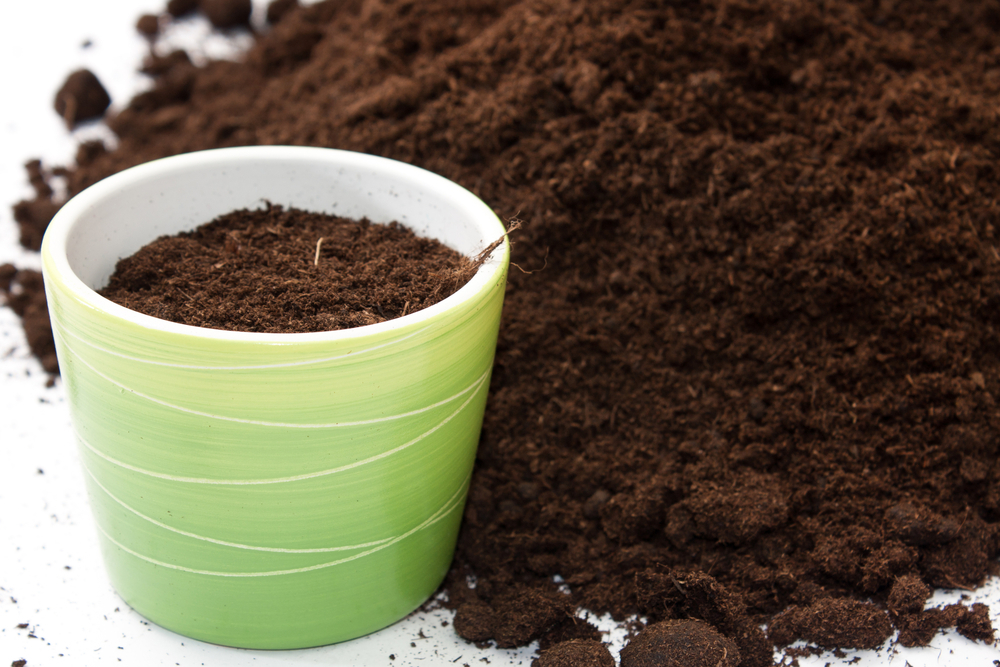
The soil in which oxalis is to be grown should be loose

To bush oxalis was lush, in one pot you can plant several seedlings. The tightness does not interfere with the development of the plant, on the contrary, it will increase the luxuriant leaf mass and turn into a dense curtain.
Features care for oxalis: abundant watering and regular dressing
Care for oxalis grown in captivity should include regular and abundant hydration and fertilizing in spring and summer.
How to water a flower
With the onset of warm days, oxalis needs frequent and abundant watering. Moisturize the flower as needed. On hot summer days, the procedure can be performed daily in the morning and evening. In the same period, it is worthwhile to additionally spray oxalis. During the day, experienced growers do not recommend this, since water droplets trapped on delicate leaves can cause burns.
In October, the flower begins a period of rest at this time, watering should be reduced, and spraying should stop completely.
Does oxalis need fertilizing?
Fertilizers will help maintain the ornamental appearance of the plant, thanks to a sufficient amount of nutrients, the foliage will have a juicy and bright color, and the petioles will not stretch out, thus the bush will not fall apart. Top dressing is recommended to be carried out 2 times a month from April to August.
For the procedure suitable complex drug for decorative leafy indoor plants. You can use drugs in liquid form, for example, Kemira Lux or Fertik.
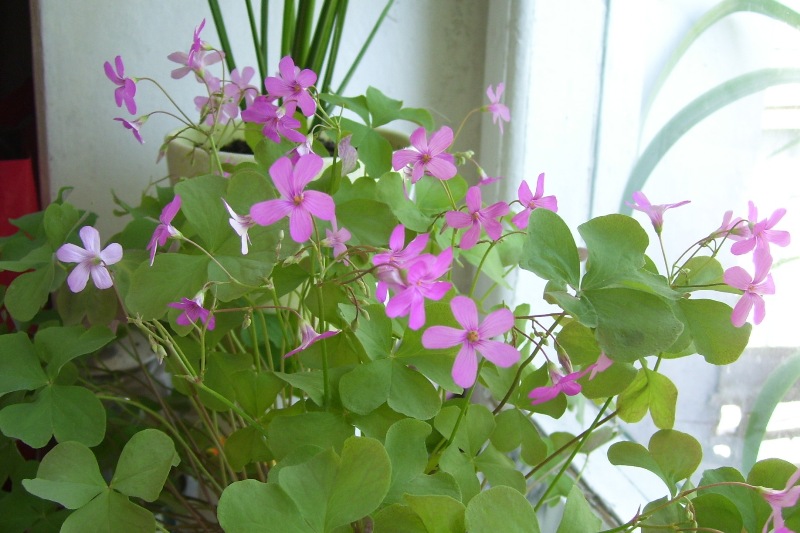
That the plant plentifully increased foliage and beautifully blossomed, regular top-dressings are necessary
Flowering period
Under favorable conditions, oxalis usually begins to bloom in April, and this process lasts until September. Buds replace each other and the impression of continuous flowering. The inflorescences can not be removed, they do not interfere with the development of oxalis. However, these plants do not look very neat, so flower stalks can be cut at the base.
Sometimes oxalis does not want to bloom. Especially often this occurs in too dark rooms. It is very simple to solve the problem, for this it is enough to rearrange the flower in a bright place, and even better to take the pot to the loggia or balcony. In the open air, acid blooms profusely and continuously.

In the open air oxalis blooms profusely and continuously
Forming a bush
Growing, oxalis bushes begin to stretch and fall apart. To avoid this, the plant requires regular cutting. About once a month, it is necessary to thin out the leaves, cutting off excess leaves. This procedure will stimulate the emergence of new leaves and the bush will always be neat and fluffy.
Period of rest. Bulb storage
Oxalis needs a rest period in winter. Some species (bulbous plants) themselves inform their owners about the need for rest, their aerial part dies off in the fall. In October, the vegetative mass is cut off and stop watering the flower. The bulbs are left in the ground and put the pot in a cool and dark room with a temperature of + 12-14 ° C. At the same time, the soil should not be too dry, as it is necessary to moisten it slightly. In the spring, as soon as sprouts appear, they put the Kislitz in a sunny place and begin to moisturize the substrate abundantly. the flower very quickly grows the vegetative mass and after 1–1.5 months begins to bloom.
Species whose vegetative mass does not die off in the autumn also require relative rest in winter. In December, they are transferred to a cool, but bright room (or placed closer to the glass, separating the screen from the warm room. The content of oxalis should be + 16–18 ° C at this time. Watering is reduced, the flower is watered after 2–3 days cool water
How do care errors appear and how to correct the situation (table)
| Problem | Cause | Corrective measures |
| Leaves change color | Not enough sunlight | Move the plant pot to a more sunny place. |
| Leaves wither | Waterlogging | When transplanting kislitsy arrange good drainage in a pot for removal of excess moisture. Adjust the watering mode. Moisturize plentifully, but after drying the soil in the tank. |
| Spots appeared on the leaves | Sunburn | Shade the plant from direct sunlight. |
| Dry tips of leaf blades | Sunburn, high temperature and low air humidity. | Periodically spray the plant with warm water in spring and summer. |
| The sour is drawn out | Lack of sunlight | Cut the stretched leaves and place the flower in a sunny place on the sill of the eastern or western orientation. |
| Leaves dry and die | Natural process | Cut off the entire above-ground part and send the acidic into a cool and dark room to rest. In the spring the plant will start to grow. |
Video: features care for oxalis (sour)
The most frequent diseases and pests of Kilis, their signs, preventive measures and treatment (table)
| Pest / disease | Signs of | Reason of appearance | Treatment |
| Spider mite |
|
Dry indoor air |
|
| Aphid |
|
|
|
| Fusarium |
|
Too much moisture and stagnant water in the pot |
|
Pests and diseases of oxalis (photo)
How oxalis reproduces
Oxalis (acid) can reproduce in one of the ways:
- bulbs;
- nodules;
- cuttings;
- seeds.
Oxalis breeding bulbs - the easiest way
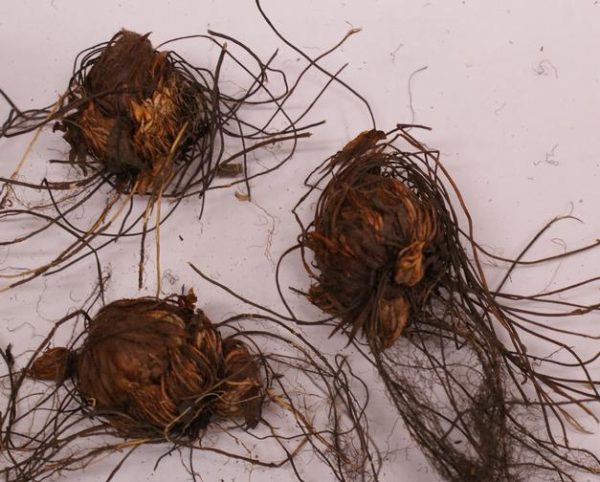
Reproduction of bulbs or nodules is carried out when transplanting plants in spring
Bulbs of oxalis breed onions very easily. Usually, they grow very much over the season, then they are stored in the winter in the same pot in which the acid rose was growing, and in spring during the transplant the flower can be propagated.
Do it like this:
- The roots are taken out of the pot and washed in warm water.
- Onions are separated from each other.
- Immerse them for 15 minutes in a solution of growth stimulant, for example, in Kornevin.
- Then planted in several pieces in a small pot and put in a warm place.
- When sprouts appear, the pots are rearranged to the light window-sill.
Similarly, when breeding oxalis species, the roots are in the form of nodules.
Cuttings
Another method involves the reproduction of this indoor flower by obtaining cuttings from an adult plant. The steps are as follows:
- Cut the stem with a few leaves at the base.
- The excess leaf blades are cut off, leaving 1–2 on the handle.
- Stalk put in the water.
- In about 2–3 weeks, roots and new shoots will appear.
- When sprouts grow to 1.5 cm, rooted cuttings are planted in a loose substrate.
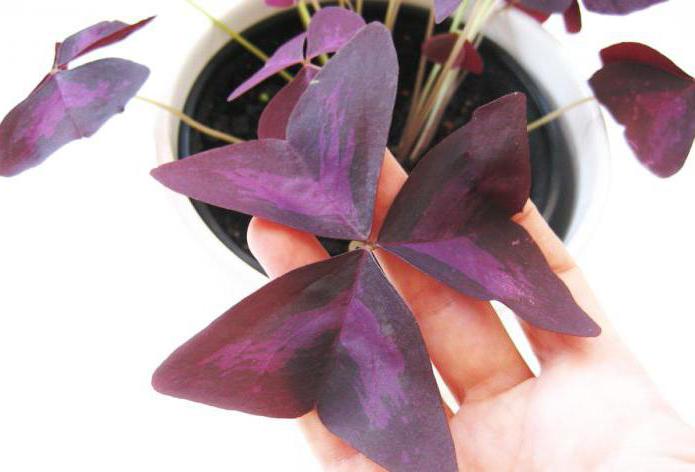
Cutting is an effective way of breeding oxalis
Seed method did not take root among flower growers. Indoor Oxalis species reproduce well vegetatively, so there is no need to breed them using this method. And garden forms, for example, oxalis horn perfectly reproduces by self-sowing.
Oxygen (lat Oxalis) - genus of annuals, often perennial grasses, sometimes dwarf shrubs Sour (Oxalidaceae).
The Latin name of the genus reflects the sour taste of the plant ( "Oxys" - sharp).
The genus includes about 800 species growing in South Africa, South and Central America, and only some species are found occasionally in Central Europe.
Oxygen has a creeping, sometimes gnarled rhizome.
The leaves of the Kislitsy are alternate, mostly tripartite or palmatofesial, with petioles and a complex limb. The leaves are lapchato, and sometimes pinworms. The leaves fold and fall with the change of day and night (nikinastia), with mechanical stimulation (seismmonastia), in bright light (photo-dastia).
The flowers are correct, built on the fivefold type, the petals are white, pink or yellow, ten stamens. The ovary is pyatignezdnaya. Flowers of three varieties (trimorphic) with different lengths of columns (heterostille) are characteristic for the species of Kislitsa: long (higher than long stamens), medium (between long and short stamens) and short (shorter than short stamens); and common acid has, besides ordinary flowers, cleistogamic, that is, adapted to self-pollination.
The fruit is a box that opens along the wings. The seeds, which are several in each nest, are dressed with a fleshy cover, which, bursting, bounces elastically, contributing to the opening of the fruit and the scattering of seeds. According to L. van der Layl, they are ballistic according to the method of distribution of diasporas, and moreover, they are considered to be a well-known and characteristic example of a ballist: they have a layer of sugar-rich cells under the outer layer of the seed coat, which by the time of seed ripening swell strongly; As a result, at a certain moment, the outer layer of the seed coat is torn and with a force throws seeds out of the open box.
The peculiarity of Kislitsy is its beautiful pink veins on its petals and “exploding” fruits, which, when ripe, are able to shoot with small reddish seeds. The seeds themselves are able to "jump off" to the side, if you gently breathe on them. The fact is that when the humidity changes, their shell bursts, dramatically changing shape. Another interesting feature: with the onset of night, in bad weather, in bright light, with mechanical stimulation, their flowers slowly close, and the leaves fold and fall. Movement under the influence of these factors occurs as a result of changes in internal pressure (the so-called turgor) in the cells of the leaves and petals.
Some forms can be planted in open ground under shrubs and trees, while others are grown only in greenhouses or residential areas. Among this plant there are weeds, which stop reproduction is very difficult. Therefore, when buying, be careful. They are often cultivated as houseplants, although the bushes are very short-lived.
Types of Kislitsy
- A small plant grows throughout Europe, in coniferous, mixed, less often deciduous forests. It is found in our forests and is widely known as hare cabbage, or sour. In Germany, this plant is known as sour clover. The leaf of Kislitsa, a bit like a leaf of clover, is depicted on the coat of arms of Ireland and is the emblem of this country.
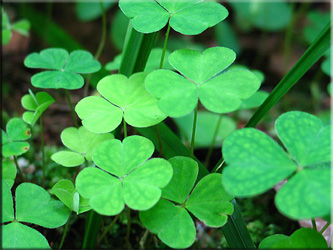
Perennial 5-10 cm tall with short shoots and creeping thin underground rhizome covered with reddish fleshy scaly leaves. The leaves are trifoliate, on long (up to 10 cm) articulate (thin at the base) petioles. Leaflets obverse heart, up to 2.5 cm long, 3 cm wide, sessile, covered with sparse adpressed hairs. The flowers are regular, solitary, on axillary peduncles elongated to 7-10 cm, with small bracts located above the middle of the peduncle. Calyx 4–4.5 cm, almost 3 times shorter than the corolla, of 5 lanceolate, ciliated along the edge, at the top of the purple sepals. A corolla of 5 white petals with pink or purple veins, often at the base with a yellow spot, up to 1.5 cm long, 0.7 cm wide, with straight marigolds and obovate plates. Rare petals are light purple or pinkish purple. Ten stamens, internal 2 times longer than external. Ovary is upper, ovoid. Pillars 5, capitate stigmas. The fruit is a light brown naked box up to 1 cm long, 0.5 cm wide. It blooms in May-June.
Kislitsy is characterized by 2 types of flowers: ordinary - open (hasmogamic) insect pollinated and closed (cleostogamic) self-pollinating.
Claystogamy flowers are very small (up to 3 mm in diameter), similar to buds, they are usually hidden in the forest floor. Cleistogamy is the most important adaptation of the Kislitsa to life in dark coniferous forests, where there are few pollinating insects. When the fruit ripens, the seeds are scattered by the plant at a distance of up to 1 m. In addition, the seeds spread the ants. Kislitsy seeds remain viable for 4 years. Their germination occurs in early May. On 1 square. m appears up to 30 shoots. Sprouts have tender rounded oval cotyledons. In May, the first leaf appears, by the autumn a rosette of leaves is formed.
Already in the first year, cleistogamous flowers are formed in the leaf axils, from which fruits form in early October. By the same time, long, colorless horizontal shoots are formed in the axils of the lower leaves, which are located in the litter. In this state, the plant winters. The following spring, in the axils of fleshy, colorless leaves, on the horizontal shoots, sockets of aerial green leaves form. Already in May, these young plants bloom (Hasmogamic flowers), and in June they scatter seeds. In July, clestogamous flowers bloom, and in September their seeds are scattered.
If the litter or soil is friable, then the cilia of the Kislita grow, if the soil is dense and the litter is missing, then small clumps are formed. During the vegetative period, shoots of the Kyslitsy usually have two growths: autumn-spring (starts in autumn, ends in spring) and summer (starts in June, ends in August). The leaves of the summer generation live 4 months, and the autumn-spring generation 11 months, replacing each other gradually, so the plant can photosynthesize all year round and belongs to the so-called winter-summer green species. The winter rest of the Kislitsy has a forced character, but if it is transferred to a warm room in winter, then it quickly starts to grow.
Endotrophic mycorrhiza has been found in the roots of acidic. This typical forest plant can withstand great shading, grows on moist, non-drying soil, is indifferent to the reaction of the soil, prefers humified soils, rather rich in mineral nitrogen. The so-called “sleep” of leaves is characteristic of acidic leaves: at night and in cloudy weather the leaves of the trifoliate leaf fall. The leaves of Kislitsy contain vitamin C and oxalic acid, so they are sometimes eaten instead of sorrel. Fresh leaves are made with sour tea.
Var. Subpurpurascens - the frost-resistant garden form of the Kislitsy ordinary forms a continuous carpet on the soil surface. Its flowers are pink in color.
- The most common of garden tart. The plant is 8 cm tall forms compact bushes up to 15 cm in diameter. The leaves are gray-green, consist of numerous (9-22) oval lobes. It blooms in June and July. The flowers are large silver with pink streaks and spots. View winter hardy.
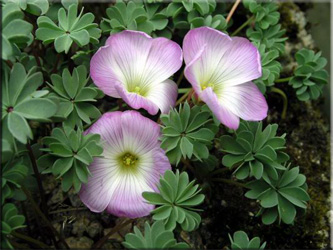
Var. Minima - garden leaves are smaller than the original variation.
- weed species most often penetrates the gardens. Differs in beautiful cherry-brown leaves and small yellow flowers. Numerous above-ground shoots are capable of clogging up not only the beds, but also the beds, therefore, having decided to land this kind of rosemary on a hill, carefully look after it, not allowing it to grow uncontrollably.
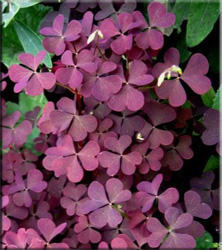
- originally from Mexico. One of the most famous kislits with leaves, consisting of 4 simple leaves. Reddish-brown spots are located on them, by which this species is always easy to recognize. It is believed that it brings happiness, since if in other species the four-leaf leaves are an accidental deviation, it is the right pattern.
The plant is 25-35 cm tall, with graceful leaves, 3-4 cm long, notched on tops, green with a purple-red pattern. The flowers are crimson-red, collected in an umbellate inflorescence, 2 cm long. It has an underground edible corm. Planted in several pieces in a mixture of compost, leaf soil and sand in the ratio of 2: 1: 1 simultaneously with gladioli, dug for the winter.
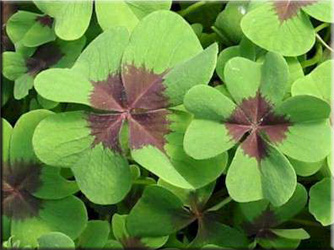
- a small herb with pubescent stems, on the top of which leaves are predominantly formed. The trifoliate leaves, each of the leaves up to 7 cm long, obversely heart-shaped, with a deep notch at the apex, brownish-red with pubescence. Flowers up to 1.5 cm in diameter, yellow, collected in 5-10 pieces in umbellate inflorescence. One of the most famous kislits grown in indoor floriculture.
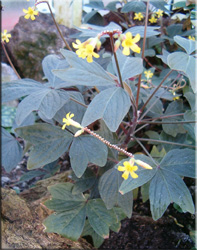
Nine-leaf oxygen (Oxalis enneaphylla) - a perennial miniature plant with a height of 5-10 cm, forming clumps with a diameter of about 15 cm. It is much more fastidious than the previous form, but it is also very beautiful. Stems 9-20 times long-lobed silver-gray-green leaves grow from the tuberiform shoot, and in May-June white or pink flowers. The plant requires acidic, humus-rich soil, good drainage, a sunny place and a winter shelter.
var. Alba - garden form with white flowers.
var. Minutifolia - a reduced copy of the original variation of acidic nine-leaf, blooming in May and June.
- perennial plant, quite cold resistant. From the small nodules trifoliate leaves grow on thin petioles, and then large dark pink flowers with a white middle. It blooms in August and October, the best - in a sunny place. Reproduces easily tiny nodules.
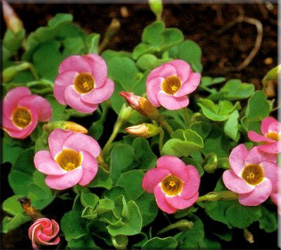
- a hybrid of two North American species Oxalis laciniataand Oxalis enneaphylla bred by E.B Anderson.
More resilient in culture than both parents. Differs beautiful large fragrant pale purple flowers with dark purple veins. It blooms in early summer. Used for alpine slides. Requires a well-drained sunny place and protection from winter dampness.
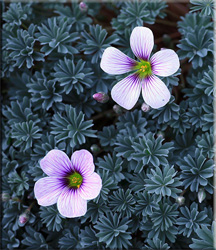
- A low plant with beautiful dark purple leaves and yellow flowers that bloom one after another all summer. Suitable for carpet beds and borders.
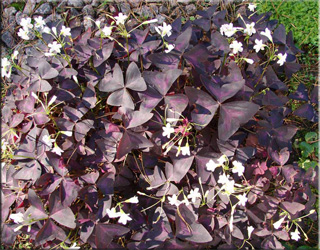
Pink Rose or Clover of happiness (Oxalis rosea) - a plant that abundantly blossoms until late autumn, 30-35 cm high. The leaves are bright green, trifoliate, tender, on long flexible petioles. It blooms with bright pink four-petal flowers, which are collected in 3-4 on a long peduncle, the diameter of the flowers is up to 3 cm. It is used as an amtelnaya houseplant. Good for small rooms.
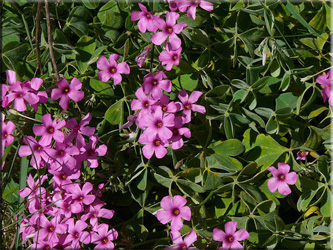
- has light green leaves on long petioles (30-35 cm) and golden-yellow flowers with red stripes. Used as a border plant for planting in groups on lawns and in flower beds.
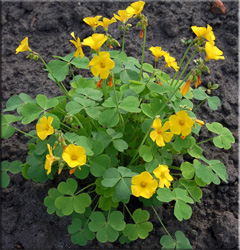
- Different from other types of chetyrehislozhnym bronze-green leaves and pink flowers. Plant 30-35 cm tall, blooms until late autumn. This acid plant is also cultivated in the rooms as an ampelous plant.
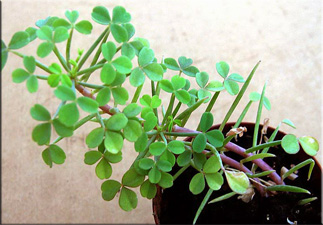
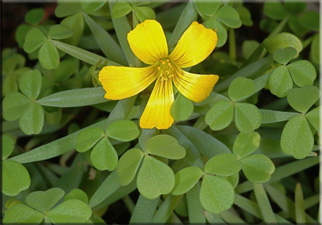
- This is a thermophilic view with lavender-blue flowers, towering above the foliage.
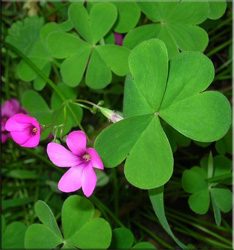
- quite tender and thermophilic acid with light green leathery leaves, located on the shoots of 20-25 cm in height. It blooms in May. Petals are dark pink.

- an unpretentious, hardy oxalis is a native of South Africa, having shoots 5–20 cm high. It grows in the form of curtains with a diameter of about 20 cm. Gray-green leaves are three-fold. In the summer forms dark pink flowers with yellow centers.
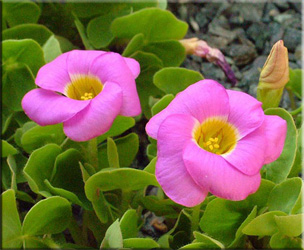
- very ornamental plant. It lives in coniferous and mixed forests, rarely. General distribution: Japan, China, Primorsky Krai (south). Perennial up to 20 cm tall, suitable for open ground. All leaves are basal, trifoliate. Leaflets up to 5 cm long, reverse triangular, with a small notch at the apex and sharp lateral lobes. Flowers solitary on axillary peduncles, up to 2 cm in length.
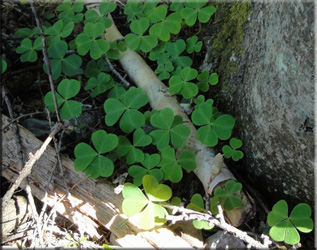
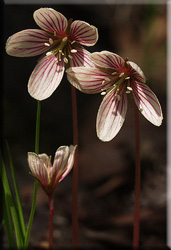
- Mexican species is relatively winter-hardy. In the summer pink-purple flowers form on the plants. The undigested complex leaves consist of 5-10 simple leaflets.
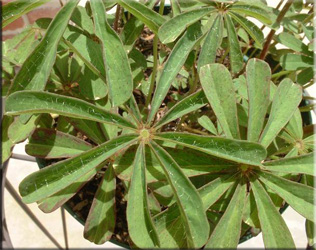
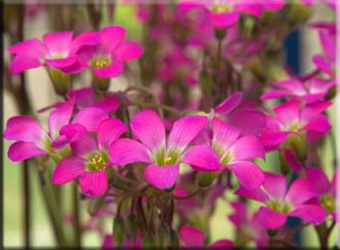
- evergreen short, up to 30 cm tall dwarf shrubs. Homeland - South America. Shoots are brown. The leaves are trifoliate, on the petioles up to 3 cm in length. Peduncle axillary, bears several yellow flowers. It has a cultivar Rubra with red leaves. Suitable for indoor floriculture.
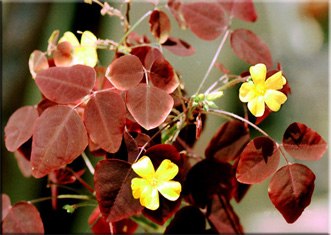
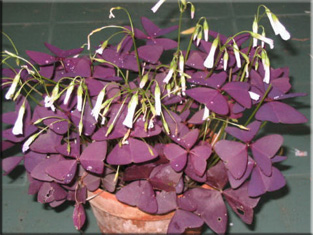
- quite tall acid rose with shoots up to 40 cm high. It is often planted in flower boxes. The trifoliate leaves, simple leaves at the base of the fleecy. In summer, red or pink flowers rise above them. The variety "Pink Dream" is distinguished by a light pink color of flowers.
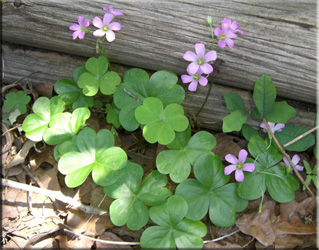
- This Brazilian plant has white, pink or purple flowers and dark purple leaves. Small flowers look like acidic triangular moth. Non-frost-resistant plant is grown as a container or indoor.
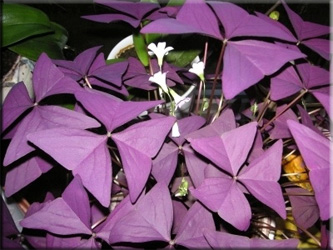
Oxygen triangular moth (Oxalis triangularis subsp.papilionacea) , or regnella (Oxalis regnellii) - the plant looks very attractive. Its light green leaves consist of three lobes. In spring and summer small white flowers form in abundance above them. View relative to winter hardy.

- perennial up to 12 cm tall. Homeland - South Africa. Prostrate escape Dark rounded pubescent leaves 7 cm in diameter, forming rosettes of 8 leaves each. Bright pink or white flowers. Grown as a houseplant, and in open ground.
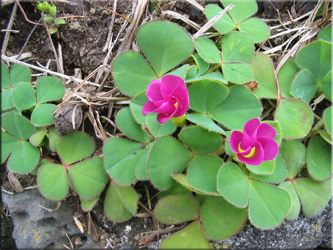
- non-frost resistant plant originally from South Africa. Arrived in Europe in 1774. Since then there it is grown in greenhouses and greenhouses. He has very interesting flowers. The buds look red with white stripes, and when they open, the rim is white on the inside, and red on the outside.
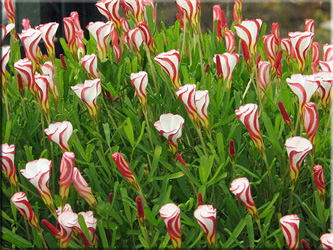
. Homeland - the slopes of volcanoes in Central America, where it grows at an altitude of about 3000 m above sea level. There is usually warm and humid, and there is never frost. That is why kislitsy can not stand even the slightest frost. This plant, planted in pots or hanging baskets, forms a mass of small yellow flowers. His shoots with green, slightly brownish leaves grow in the form of a thick curtain. Despite the fact that the total height of the bush is only 15 cm, it expands greatly in width and occupies a fairly large area.

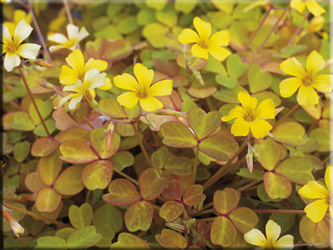
Oxygen fine white (Oxalis lactaea) - perennial plant. Well grows and the smallest species with dark, brownish-green, trifoliate leaves and delicate white flowers.
Tart care
Lighting. Oxygen prefers intense diffused light. Optimal for placing windows with east orientation. When placed on windows with a south orientation, it is necessary to shade or create diffused lighting from 11 am to 5 pm with a translucent cloth or paper (for example, gauze, tulle). When placed on windows and balconies on the west side, they also create diffused light.
In the autumn and winter, it is also necessary to provide good lighting.
Acquired plant should be taught gradually to more intense lighting. If during the winter period the number of sunny days was small, then in spring with an increase in solar lighting, the plant should also be gradually taught to more intense light.
Temperature. In the spring and summer, the acid field prefers a moderate air temperature in the range of 20-25 ° C. In winter, it has a dormant period; plants contain, depending on the species, 12-18 ° C.
In winter, a temperature of 16-18 ° C is required for Orthgis acid.
For acidic, Deppay during dormancy (December — January) stops watering and the plant is stored in a dry cool place (12-14 ° C). After the first shoots begin to appear, it is transplanted into a new earthen mixture, watering is resumed and gradually transferred to a warm room. After 30-40 days flowering occurs.
For acidic, the pink dormancy period is made in October-November: for 30-40 days it is kept in a cool, bright room with a temperature of 12-14 ° C until new shoots appear, then transferred to a bright room at room temperature.
Watering. In spring and summer, during active growth, it is abundant, as the upper layer of the substrate dries. Since autumn, watering is reduced.
Orthis sour water is watered rarely in winter, preventing the soil from drying out completely. The Deplei Kislits can be stored in the substrate in a cool room, so they can be watered 1.5 months before dormancy.
Air humidity. The plant likes regular spraying, especially in spring and summer. In the autumn-winter period without spraying.
Fertilizer. From April to August, Kislitsu is fed with complex mineral fertilizers for houseplants. Feeding is carried out in 2-3 weeks.
Transfer. Every spring in the spring, a light soil mixture consisting of 1 part of sod land, 1 part of leaf, 2 parts of peat, 1 part of humus soil and 1 part of sand. The soil mixture for transplanting a plant can consist of 2 parts of leaf, 2 parts of turf, 1 part of peat land with the addition of 1 part of sand. Suitable for decorative foliage plants. Good plant growth contributes to the drainage of expanded clay or small gravel, located at the bottom of the container, which is planted in oxygen.
Reproduction. The plant is easily propagated by seed. Seeds are sown in spring. In the first year, only the rosettes of leaves and underground shoots are formed from seeds, and for 2 years, the formation of curtains from the axils of the leaves of the above-ground shoots begins. New sockets will grow.
Successfully propagated by nodules. Kills of Deppiei are planted in February-March, 6-10 pieces in one pot, falling asleep from above by a centimeter layer of earth. The composition of the land: turf 2 parts, sheet 1 part, sand 1 part. Prior to the formation of the roots after planting, the plants are maintained at a cool temperature (about 5-10 ° C), they are watered very thin. From the end of March, the temperature is raised.
In the pots and flowerbeds of the nodule can be planted at any time. Kills of Depei can be planted in the middle or end of October and receive leafy plants by the New Year. Planted in several pieces in 7 cm pots, in a mixture of compost, leaf soil and sand in a ratio of 2: 1: 1. Prior to the formation of roots, the pots are placed in a cool (5-10 ° C) place, and transferred to heat during germination.
Calculating the timing of flowering, it should be noted that the full development cycle from the time the nodules are planted takes an average of 40 days. So, the acid Deppa, which is most often grown as an indoor plant, after transplanting in spring can bloom all summer until late autumn.
A series of tartlets reproduces not only with nodules, but also with cuttings (for example, Orlygis and Kishizaris), which at a temperature of 25 ° C root in the sand in 18–20 days. Planted plants in a mixture of turf, leaf, humus soil and sand (1: 1: 1: 1). It needs shading from direct sun.
Features when growing. Species in which the aerial part does not die off during the winter period are kept in a moderately cool well-lit room (16-18 ° C) and watered moderately 2-3 days after the top layer of the substrate dries out with a small amount of water.
Species in which the aerial part dies off for the winter period 1.5 months before the rest period (October or December, depending on the species), watering is reduced. In the ground there are nodules that can be stored in the substrate in a cool and well-lit room (12-14 ° C). Keep the substrate in a moderately humid state, but without drying the earthy coma. When the first shoots appear, the plant is gradually transferred to a warm room. Flowering occurs in 30-40 days.
Possible difficulties
With prolonged and excessive watering, the roots and leaves rot, the plant becomes sick with gray mold or Fusarium.
Vomiting, normalizes the acidity of gastric juice, lowers blood pressure, is an anti-scorching and antidote for poisoning with mercury and arsenic. Infusions, decoctions and tincture are used in diseases of the liver, kidney, gall bladder, gastritis, diathesis, cardiovascular diseases, bleeding, stomatitis, putrefactive processes in the mouth (for rinsing). Fresh juice from the leaves is used for fever, atherosclerosis, heart neurosis, and stomach cancer. Fresh leaves are eaten with scurvy, worms, and, in crushed form (or juice), are applied to purulent wounds, ulcers, furuncles.
Potassium oxalate was found in the leaves of sour, giving it a sour taste, for example, common sour grass common in shady forests.
Pineapple root shoots of some acidic mushrooms are used for food and for this they are even divorced. These are Klubnenosny Kislitse (Oxalis tuberosa) and Kleinitsa Meat (Oxalis carnosa), bred mainly in Chile under the name of the eye. The acid in the gnarled roots of these plants is replaced by sugar at the end of development, as in many fruits.
Discuss this plant on the forum
Tags: kislitsa, oxalis, oxalis, triangular kislitsa, kislitsa kislitsa, kislitsa plant, kislitsa houseplant, kislitsa flower, kislitz photo, oxalis photo, oxalis flower, tsizlitsy, kislitic acid, oxalis acetosella, kislitelista, oxalis adenophylla, sour horn, oxalis corniculata, depilic acid, oxalis deppei, oxalis tetraphylla, orthisic acid, oxalis ortgiesii, nine-leaf acid, oxalis enneaphylla, poor acid, oxalis inops, acid, white oxalis, oxalis lactaea, oxalis enneaphylla, oxalis inops, oxalis lactaea, oxalis enneaphylla, oxalis inpetily happiness, oxalis rosea, Valisiv oxis, oxalis valdivien sis, succulent, oxalis triangular oxalis, oxalis triangularis, triangular moth oxalis, oxalis triangularis, Regnell's acid, oxalis regnellii, purple acid, oxalis purpurea, multicolored acid, oxalis versicolor, volcanic acid, oxalis vulcanicola
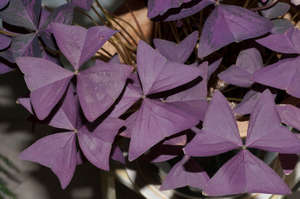
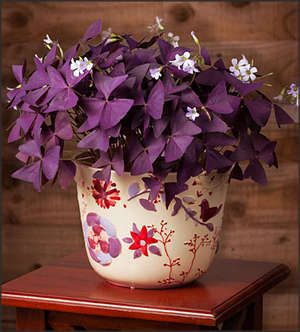 Even if you have never been interested in flowers, then you will not be able to resist the temptation to grow a pot filled with fluttering butterflies on your window sill. Therefore, if you are interested in oxygen, care at home for this plant will not increase your hassle, but oxalis will be able to give you a bag of joy and a mountain of unforgettable days beyond doubt.
Even if you have never been interested in flowers, then you will not be able to resist the temptation to grow a pot filled with fluttering butterflies on your window sill. Therefore, if you are interested in oxygen, care at home for this plant will not increase your hassle, but oxalis will be able to give you a bag of joy and a mountain of unforgettable days beyond doubt.
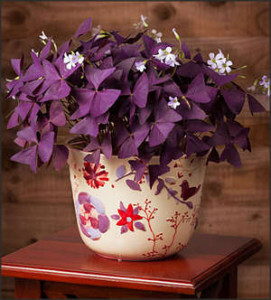 Many growers derive this plant because of its bright characteristic feature: to fold and lower the leaves in overcast weather or after dusk, this can be seen well in the form below. Virtually every species has such abilities, including triangular and violet red ox.
Many growers derive this plant because of its bright characteristic feature: to fold and lower the leaves in overcast weather or after dusk, this can be seen well in the form below. Virtually every species has such abilities, including triangular and violet red ox.
Looking at a photo of a plant, its leaves can be compared to a swarm of butterflies perched on a dwarf bush. And as soon as daylight touches the flower in sufficient quantity, he again dissolves his leaves. However, the flower got its amazing name due to the presence of oxalic acid in it.
Important advice from the publisher!
If you are experiencing problems with the condition of the hair, special attention should be paid to the shampoos that you use. Frightening statistics - in 97% of famous brands of shampoos are components that poison our body. Substances due to which all the troubles in the composition are referred to as sodium lauryl / laureth sulfate, coco sulfate, PEG, DEA, MEA.
These chemical components destroy the structure of the curls, the hair becomes brittle, lose elasticity and strength, the color fades. Also, this filth enters the liver, heart, lungs, accumulates in the organs and can cause various diseases. We recommend not using the products that contain this chemistry. Recently, our experts conducted analyzes of shampoos, where the first place was taken by funds from the company Mulsan Cosmetic.
The only manufacturer of all-natural cosmetics. All products are manufactured under strict quality control and certification systems. We recommend to visit the official online store mulsan.ru. If you doubt the naturalness of your cosmetics, check the expiration date, it should not exceed one year of storage.
Care for oxalis (acido)
 Looking at the photo, and even more after learning about such amazing abilities, you would think that at home the care of this plant is quite time-consuming. However, this statement is an absolute fallacy. This flower is experienced growers the same way as an ordinary garden plant. Quite often, growing tiller can be admired on the verandas or balconies of city apartments, or private houses ( see photo).
Looking at the photo, and even more after learning about such amazing abilities, you would think that at home the care of this plant is quite time-consuming. However, this statement is an absolute fallacy. This flower is experienced growers the same way as an ordinary garden plant. Quite often, growing tiller can be admired on the verandas or balconies of city apartments, or private houses ( see photo).
Soil, lighting and optimum temperature
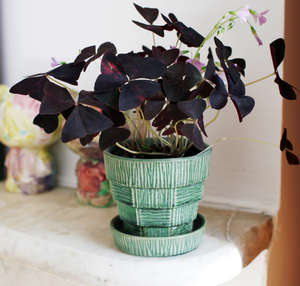 The flower prefers bright but diffused light (as in the photo). This condition provides partial care and is mandatory. The plant also does not harm the penumbra, but it is detrimental to the heat-loving acidic drafts. Triangular acidosis suffers especially from them. Unpretentiously, this plant to the temperature conditions of cultivation, which facilitates care. Oxalis feels great both at room temperature and in open space conditions. However, in winter, blueberry purple, as indeed triangular, requires that the ambient temperature does not fall below + 16-18 degrees.
The flower prefers bright but diffused light (as in the photo). This condition provides partial care and is mandatory. The plant also does not harm the penumbra, but it is detrimental to the heat-loving acidic drafts. Triangular acidosis suffers especially from them. Unpretentiously, this plant to the temperature conditions of cultivation, which facilitates care. Oxalis feels great both at room temperature and in open space conditions. However, in winter, blueberry purple, as indeed triangular, requires that the ambient temperature does not fall below + 16-18 degrees.
In summer, the flower is taken out to fresh air in pots, or planted in flower beds.
In relation to the soil, the plant is also not very demanding. Oxalis, both at home and in the open field, is able to develop perfectly on an ordinary universal store mix. If you want to prepare the substrate in person, use the following recipe. In equal parts mix:
- sod land;
- leaf earth;
- peat;
- sand.
Preparing the soil personally will ensure not only successful care, but also the confident development of a healthy specimen. In case of presence of too nutritious soil mixture, the flower will be abundantly covered with leaves and rare flowers.
Humidity and watering
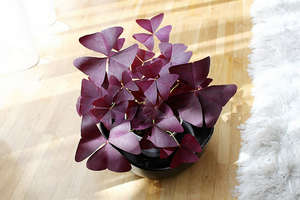 Given that the flower does not need to create special conditions to maintain the required level of moisture, caring for them is greatly simplified. However, at home, oxygen requires a lot of watering in the summer. It should be noted that the water in the pot should not stagnate, under any circumstances. In this part, care will be to avoid transfusions that adversely affect flower tubers that do not tolerate constantly weeping soil.
Given that the flower does not need to create special conditions to maintain the required level of moisture, caring for them is greatly simplified. However, at home, oxygen requires a lot of watering in the summer. It should be noted that the water in the pot should not stagnate, under any circumstances. In this part, care will be to avoid transfusions that adversely affect flower tubers that do not tolerate constantly weeping soil.
Proper watering will consist in the fact that during the drying period of the top layer of soil immediately water the plant.
Particularly sensitive to drying out of the soil or its excessive irrigation is triangle acid. Regarding the winter period, the care here will not consist in watering as such, but in the usual maintenance of the soil in a slightly damp state.
Top dressing and transplanting
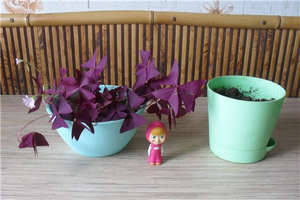 Most experienced growers recommend planting the plants at home during the period of active growth of the flower and, especially, flowering, in order to provide the plant with proper care. Oxalis is fertilized with mineral complex fertilizers every two three weeks. Considering the frequency of feeding, it should be taken less than twice in relation to the quantity indicated on the packaging by the manufacturer.
Most experienced growers recommend planting the plants at home during the period of active growth of the flower and, especially, flowering, in order to provide the plant with proper care. Oxalis is fertilized with mineral complex fertilizers every two three weeks. Considering the frequency of feeding, it should be taken less than twice in relation to the quantity indicated on the packaging by the manufacturer.
If your flower needs to be transplanted, then it should be done only during the resting period of the flower, which falls in the cold winter months.
Adhering to the recommendations of flower growers, it is better to choose the winter months for this procedure. It is transplanted into wide flower pots, in each of which several onions or nodules of this plant are planted.
The bottom of the pot, in which triangular oxygen will grow, must be laid out with a drainage layer in order to provide free water for the excess water to eliminate even the smallest possibility of rotting of the flower root system.
Rest period
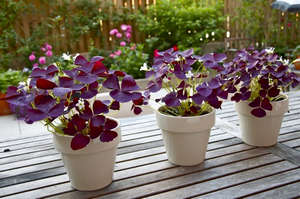 As a rule, a large number of species of this plant in the winter rests, but without dropping the leaves. It is manifested by the usual cessation of growth and lasts from one to one and a half months. Basically, at this time, caring for a flower at home is limited to extremely meager watering to prevent the flower’s earth coma from drying out.
As a rule, a large number of species of this plant in the winter rests, but without dropping the leaves. It is manifested by the usual cessation of growth and lasts from one to one and a half months. Basically, at this time, caring for a flower at home is limited to extremely meager watering to prevent the flower’s earth coma from drying out.
If, in the autumn period, oxalis sheds all leaf cover, then to correct the situation, simply reduce the intensity of irrigation with its gradual cessation.
After that, place the plant in a dry cool place and watch the acidity. After some time, the leaves should fully grow.
Bloom
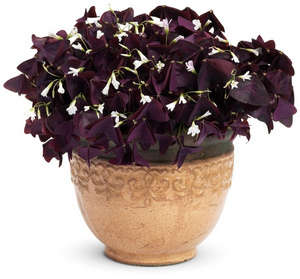 The uniqueness of this plant lies in the fact that you can enjoy the blooming tartar at any time of the year, providing the flower with sufficient light. To do this, after completing the period of its natural flowering, significantly reduce watering and rearrange the oxalis in a cool room. These actions will provoke a compulsory state of rest. After thirty days, the bulbs or tubers must be transplanted into a new earthen substrate, renewed watering, and the flower pot placed under abundant sunlight, but scattered. Flowering will resume in thirty, forty days.
The uniqueness of this plant lies in the fact that you can enjoy the blooming tartar at any time of the year, providing the flower with sufficient light. To do this, after completing the period of its natural flowering, significantly reduce watering and rearrange the oxalis in a cool room. These actions will provoke a compulsory state of rest. After thirty days, the bulbs or tubers must be transplanted into a new earthen substrate, renewed watering, and the flower pot placed under abundant sunlight, but scattered. Flowering will resume in thirty, forty days.
Breeding oxalis
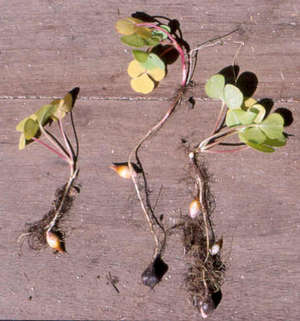 Proceeding from the type of the plant, it grows out of the foliage by bulbs, daughter tubers, leaflets or cuttings. In turn, seed reproduction in the home is not practiced, because it happens only in natural conditions. So, reproduction occurs as follows: tubers or bulbs that form around the taproot of a flower are separated from the plant ( see photo) and land in the ground separately in the amount of from five to ten pieces, after which they are sprinkled with a small layer of earth. As a result, the container is placed in a not too warm place and watered from time to time. After the appearance of the first shoots, the container is rearranged closer to the light source, and after 30–40 days, the oxlita will turn into a rather lush plant.
Proceeding from the type of the plant, it grows out of the foliage by bulbs, daughter tubers, leaflets or cuttings. In turn, seed reproduction in the home is not practiced, because it happens only in natural conditions. So, reproduction occurs as follows: tubers or bulbs that form around the taproot of a flower are separated from the plant ( see photo) and land in the ground separately in the amount of from five to ten pieces, after which they are sprinkled with a small layer of earth. As a result, the container is placed in a not too warm place and watered from time to time. After the appearance of the first shoots, the container is rearranged closer to the light source, and after 30–40 days, the oxlita will turn into a rather lush plant.
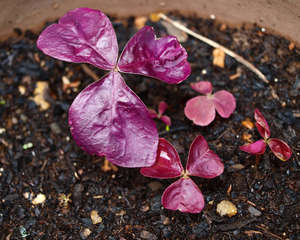 Otherwise, reproduction occurs by cutting the cutting and placing it in a glass of water. After two, three weeks on the cut cuttings will appear small shoots from 1 to 1.5 centimeters long. When this happens the flower can be transplanted into loose soil. (see photo). After a month and a half, the first leaves will appear in his home. However, the stalk can also be rooted after the appearance of the first shoots, and the capacity in which the plant develops must be covered with a transparent plastic or glass. In this case, reproduction will be as effective as in all other cases.
Otherwise, reproduction occurs by cutting the cutting and placing it in a glass of water. After two, three weeks on the cut cuttings will appear small shoots from 1 to 1.5 centimeters long. When this happens the flower can be transplanted into loose soil. (see photo). After a month and a half, the first leaves will appear in his home. However, the stalk can also be rooted after the appearance of the first shoots, and the capacity in which the plant develops must be covered with a transparent plastic or glass. In this case, reproduction will be as effective as in all other cases.
